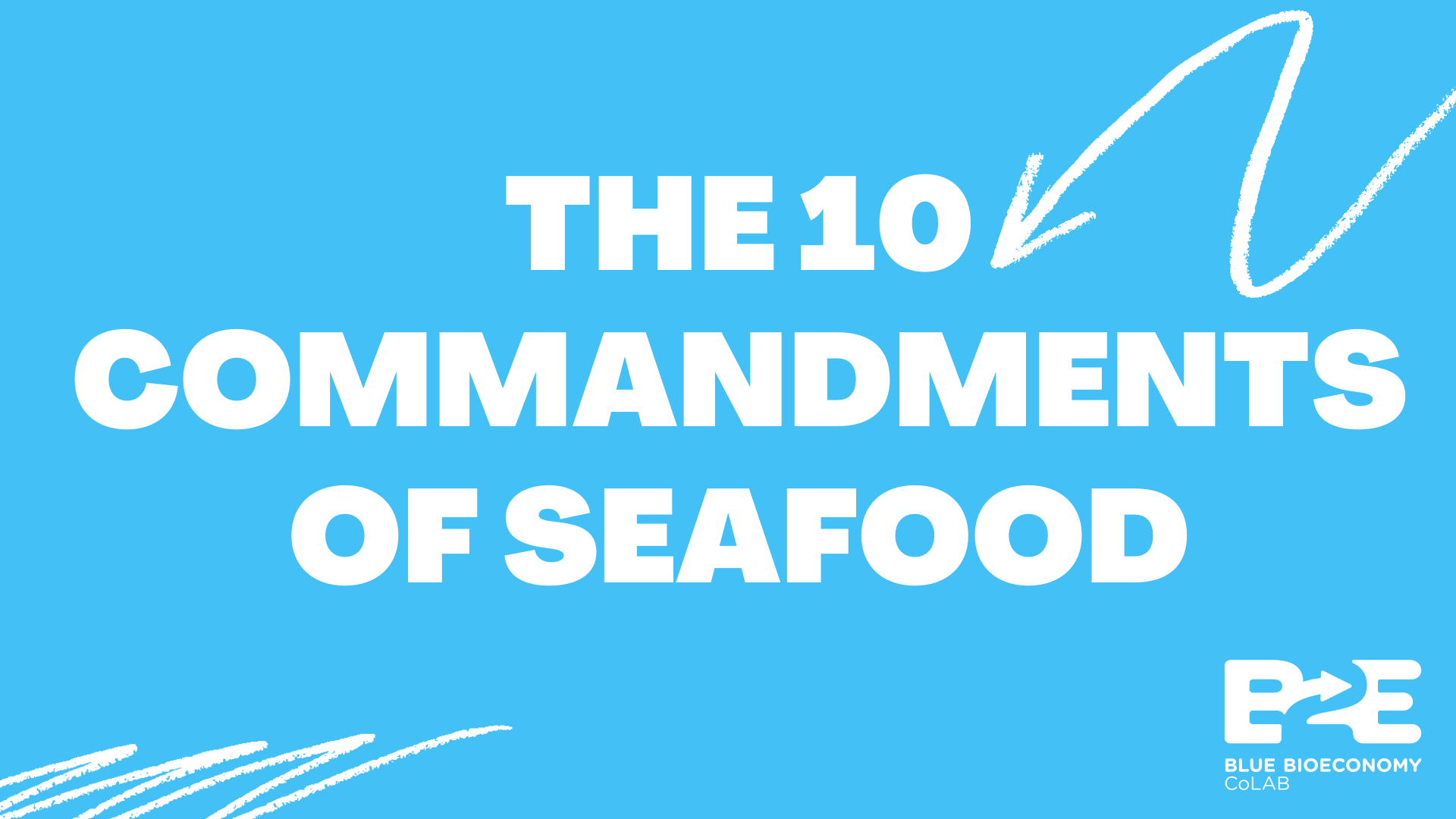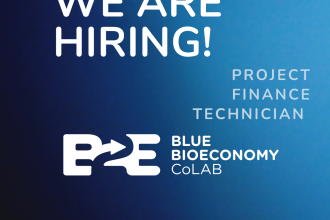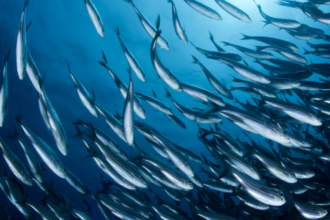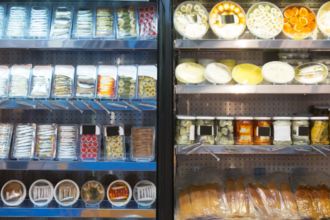The 10 Commandments of Seafood
Blue Bioeconomy CoLAB launches a new campaign to help consumers choose the freshest, healthiest, most environmentally and economically sustainable seafood.
What is your decision process when buying seafood? Do you find it difficult to choose fish at the fish stand, when you shop online or when you look at the menu at the restaurant? Want to better understand price differences? Do you have questions about the species, origin or freshness and flavour of fish? To help in making decisions about which seafood to consume, the Blue Bioeconomy Collaborative Laboratory (CoLAB B2E) launches this Thursday the Digital Guide “The 10 Commandments of Fish”, available on the website and social media (Instagram, Facebook and LinkedIn).
The 10 Commandments of Seafood
- Love local, national or European seafood whether it is from aquaculture or the wild
- Do not consider all aquaculture seafood equally
- Consume aquaculture seafood, local and national, on festive days… and on all others
- Honour lesser-known wild species
- Favour the consumption of seafood over all other animal proteins
- Do not contribute to illegal fishing: choose local, national or European fish whenever possible. In the absence of these, opt for certified fish with indication of the country of origin
- Don’t deprive yourself of exquisite taste: aquaculture seafood is as tasty as wild seafood
- Do not take false statements against aquaculture seafood or wild seafood of national or European origin
- Do not wish for species that do not exist in Portugal or are endangered
- Do not lust “sloppy” fish – always demand fish with bright pupils, firm skin and flesh, ocean aroma and brightly coloured gills
“Our mission is to stimulate the blue bioeconomy in Portugal: we make the connection between Science and Industry, and we also aim to raise awareness among the general public about the quality, safety and flavour of national seafood, whether from aquaculture or the wild”, reveals the Technical-Scientific coordinator of CoLAB B2E Elisabete Matos.
Learn about the 10 Commandments of Fish
- Love local, national or European seafood whether it is from aquaculture or the wild
Freshness: Did you know that seafood (fish, shellfish and shellfish) both from Portuguese aquaculture and the wild, as a rule, reach the market in less than 24 hours?
Environmental sustainability: In addition to being more ecologically sustainable and fresh, by consuming fish or seafood from aquaculture or the wild, whether local or national, you are contributing to the reduction of the carbon footprint.
Economy: Consuming local seafood also contributes to the stability and sustainability of the trade balance: currently around 65% of seafood consumed in the EU is imported.
Food Safety: All food products in the EU follow a strict food safety control and, from the outset, production must comply with duly regulated standards.
Antibiotics are not used preventively. The preventive use of antibiotics was banned in the EU in 2006. When it is necessary, for clinical reasons, to give antibiotics to fish, this process is done by a certified veterinarian, using as little as possible and as allowed by law. After the antibiotic treatment, fish go through a “mandatory quarantine” process, being retained until all traces of antibiotics disappear, and only after this period fish may be harvested for human consumption.
All hormones have been banned since 1981. In other words, they have not been used in the EU, in any type of animal production, for precisely 40 years.
- Do not consider all aquaculture seafood equally
Cost: There are many factors that determine the final price of a product. In the case of fish, for example, the specific diet (adapted to each cultivated species), time of year and stage of development have great influence; transport and storage logistics; the specialization and training of company employees; taxes and even issues such as the cost of production and the type of aquaculture.
Example: 1 kilo European seabass produced in domestic aquaculture, in a semi-intensive regime, takes, on average, two years to grow. By buying this fish, you are ensuring increased quality and freshness compared to a same weight seabass from outside Portugal and which has grown faster (intensive regime).
Flavour and Freshness: We easily imagine that an aquaculture in the Atlantic requires more infrastructure and personnel resources than an aquaculture in the Mediterranean Sea. But the flavour is not the same either, because our fish is really unique.
“Due to the upwelling phenomena, [oceanographic phenomenon that consists in the rise of deep waters, rich in nutrients, to the surface water layer of the ocean] the Atlantic is very rich in nutrients and generates fish with higher – both from fisheries and aquaculture”, says Elisabete Matos.
It is partly thanks to this phenomenon that brands have been developed indicating national fish as the best in the world, examples being the “World’s Best Fish” developed by the Municipality of Matosinhos, or the book “The Best Fish in the World” by Fátima Moura, financed by the predecessor of Mar 2020 programme, and which includes testimonies from researchers and renowned chefs, such as Ferran Adriá or Joan Roca, who praise the unique qualities of Portuguese fish.
- Consume aquaculture seafood, local and national, on festive days… and on all others
Quality: if you consider the origin of seafood and choose local and national, you will be guaranteeing flavour, nutrition and freshness, essential characteristics for special meals.
Nutrition and Health: Like wild seafood, aquaculture seafood is rich in vitamins A and D, important minerals (iodine, zinc, magnesium, iron, selenium) and has low cholesterol levels along with highly digestible proteins. It is also richer in fat than wild fish, which contains the desired omega-3s, essential for the cardiovascular system and useful in combating depressive states.
Environment: Nowadays, aquaculture diets include less and less ingredients of wild marine origin (i.e., fishmeal and fish oil of wild origin), relying more and more on sustainable ingredients of animal and vegetable origin – including fishmeal and fish oil made with co-products from the canning industry. This allows to reduce the FIFO (fish in – fish out) ratio, a way of calculating how many kilos of wild fish are needed to produce one kilo of aquaculture fish. Today this ratio, for most species, is less than 1, which means that production relies less and less on these unsustainable ingredients.
- Honour lesser-known wild species
Golden Tip: by consuming less sought-after wild species, you are promoting your health (acquiring different combinations of nutrients), saving money (as they are usually more affordable due to less demand/supply pressure), reducing the environmental footprint (by selecting protein that is already harvested and ready to consume, which otherwise could go to waste) and respecting fish stocks (by not consuming fish that is already in high demand and with decaying stocks).
- Favour the consumption of seafood over all other animal proteins
Producing different types of animal protein and including it in our diets puts pressure on natural resources to different extents. One way to assess this pressure is the “feed conversion ratio”, a calculation that determines how much feed is needed for the animal to gain one kilogram of body mass. Through this calculation we can verify that the production of fish (in this case salmon) is about seven times more efficient than the production of beef.
Furthermore, when comparing an animal’s ability to retain protein and energy, and to convert feed into meat, fish is by far the winner.

(Source: Global Aquaculture Alliance and NOFIMA) Analysing the figure it can be confirmed that a fish fed 100 kilos of feed produces 61 kilos of edible meat. On the other hand, a chicken fed 100 kilos of feed produces 21 kilos of edible meat. For pigs and cows, this number is even lower – 17 kilos and 4 to 10 kilos, respectively.
- Do not contribute to illegal fishing: choose local, national or European fish whenever possible. In the absence of these, opt for certified fish with indication of the country of origin
That said, certified aquaculture products are a wise choice, as it guarantees the consumer total safety and confidence in the entire process, from farm to fork.
- Don’t deprive yourself of exquisite taste: aquaculture seafood is as tasty as wild seafood
Nutrition and Health: Like wild fish, aquaculture fish is rich in vitamins A and D, important minerals (iodine, zinc, magnesium, iron, selenium) and has low cholesterol levels along with highly digestible proteins. It is also richer in fat than wild fish, which contains the desired omega-3s, essential for the cardiovascular system and useful in combating depressive states.
Flavour: More than half of the fish consumed in Portugal, and in most countries, is already from aquaculture, but this happens, apparently, without national consumers realizing it: most consumers do not seem to distinguish aquaculture fish from wild fish. A study by Deco Proteste, carried out in 2001, promoted blind tastings with aquaculture species and their wild equivalents, and showed that, in the majority of the species studied (bream, seabass and turbot), the Portuguese preference was random, with around 50% preferring aquaculture fish and the rest wild, showing that the participants of this study did not make any distinction. In the case of trout, 80% of the Portuguese preferred the one form aquaculture–possibly due to the higher percentage of fat, making the fish more succulent.
- Do not take false statements against aquaculture seafood or wild seafood of national or European origin
Examples: There are several myths surrounding aquaculture, from the alleged lack of omega-3s in fish, to very marked differences in taste, preventive use of hormones and antibiotics, among others. Precisely to demystify these totally wrong ideas, B2E recently promoted a campaign entitled “Oh No! After all It’s Myth” which explains why they are, after all, myths, through very short videos, with accessible language (about a minute) and with scientific sources. The campaign can be seen on CoLAB’s website and social media (LinkedIn, Facebook and Instagram). It is essential to highlight that the origin (national and European) is key, as it obeys food safety rules that guarantee the superior quality of aquaculture products to the detriment of other regions of the world.
- Do not wish for species that do not exist in Portugal or are endangered
Which species should be avoided?
Consult the World Wildlife Fund’s (WWF) Fish Guide which sets out the species that should be excluded from the Portuguese diet due to sustainability and stock renewal issues. Some examples to be abolished, according to the guide, are shrimp from Mozambique, European eel or some shark species Learn more at: https://guiapescado.wwf.pt/wwf-recommendations/.
- Do not lust “sloppy” fish – always demand fish with bright pupils, firm skin and flesh, ocean aroma and brightly coloured gills
Expert tips for choosing and cooking fish:
- Analyse the overall good appearance of the fish,
- Check that it has bright pupils,
- Make sure the skin and flesh are firm,
- Ensure there is a pleasant ocean aroma,
- See if the gills are brightly coloured and have no mucus,
- If the fish is packed, check for the absence of liquids.
- When buying fillets, make sure the flesh is shiny and firm, not dull and mushy. Check the texture of the flesh to make sure it is smooth and intact, not broken nor crumbly. And make sure the flesh looks – and smells – clean/fresh; the flesh can be moist, but any moisture should be clear (not cloudy) and the flesh should never feel sticky.
- If the fish has just been caught, let it rest, especially if you will grill it, so that the skin does not stick.
- If you want to taste the fish in all its splendour, try salt-baking it – this way the fish will only cook in its own juices.





